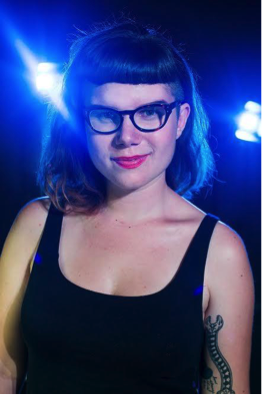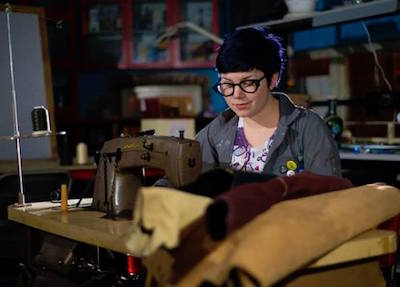Presented by Ever looked at your coffee maker and wished it could tweet? Thankfully, there’s a massive global subculture for that.Members of the amorphous “maker” community convene in studios, classrooms, and garages to tinker on projects: everything from salvaging terrible bridesmaid dresses, programming drones, or reassembling IKEA shelves into something a little less undergrad. Most aren’t professional designers. They’re just interested in exploring how they can solve common problems with creativity, technology, and their bare hands.But now that the Bay Area Maker Faire is regularly drawing 125,000+ attendees, and Arduino and Raspberry Pi quickly approach household-name status, more and more people are looking to turn their part-time making hobbies into full-time jobs. 13,100 Canadians self-identified as “craftspeople” in the last census in 2011, while 93,000 people are self-employed in the tech sector in Toronto alone. Positions can run the gamut from makerspace managers to professional Indiegogo inventors, but all require major moxie—there’s not much of a set career path in this line of work.
Ever looked at your coffee maker and wished it could tweet? Thankfully, there’s a massive global subculture for that.Members of the amorphous “maker” community convene in studios, classrooms, and garages to tinker on projects: everything from salvaging terrible bridesmaid dresses, programming drones, or reassembling IKEA shelves into something a little less undergrad. Most aren’t professional designers. They’re just interested in exploring how they can solve common problems with creativity, technology, and their bare hands.But now that the Bay Area Maker Faire is regularly drawing 125,000+ attendees, and Arduino and Raspberry Pi quickly approach household-name status, more and more people are looking to turn their part-time making hobbies into full-time jobs. 13,100 Canadians self-identified as “craftspeople” in the last census in 2011, while 93,000 people are self-employed in the tech sector in Toronto alone. Positions can run the gamut from makerspace managers to professional Indiegogo inventors, but all require major moxie—there’s not much of a set career path in this line of work. Toronto-based Hillary Predko has managed to successfully craft a career out of her passion for making. A specialist in wearable tech, she’s also a teacher at the Ontario College of Art and Design, a designer at GUILD eyewear, and the co-founder of Little Dada, an agency of creative technologists working for social change. In her spare time, Predko is an event coordinator for the Toronto Maker Faire, runs the monthly @MakeFriendsTO meetups, and co-founded the MakeChange conference.Interested in a full-time career in making? Here’s how Hillary did it:For those of us who aren’t so tech savvy, how would you define the maker community?The maker movement is a loosely associated series of communities that are based around the DIY ethos. It’s fundamentally about getting together to share tools and make different things. Everything from knitting communities meeting in yarn shops to hackers meeting to work on networks in hack spaces across the city can classify as part of the movement. What ties everything together is people coming together to do this collectively, and using a whole bunch of different approaches to information and the built world.
Toronto-based Hillary Predko has managed to successfully craft a career out of her passion for making. A specialist in wearable tech, she’s also a teacher at the Ontario College of Art and Design, a designer at GUILD eyewear, and the co-founder of Little Dada, an agency of creative technologists working for social change. In her spare time, Predko is an event coordinator for the Toronto Maker Faire, runs the monthly @MakeFriendsTO meetups, and co-founded the MakeChange conference.Interested in a full-time career in making? Here’s how Hillary did it:For those of us who aren’t so tech savvy, how would you define the maker community?The maker movement is a loosely associated series of communities that are based around the DIY ethos. It’s fundamentally about getting together to share tools and make different things. Everything from knitting communities meeting in yarn shops to hackers meeting to work on networks in hack spaces across the city can classify as part of the movement. What ties everything together is people coming together to do this collectively, and using a whole bunch of different approaches to information and the built world. How’d you get into this line of work?I started sewing at a young age, and then I quickly got into the indie craft movement. My first job was at a sewing studio in the east end. From there, I started doing craft shows, and then worked as a seamstress for a long time. Then my background in fashion started to coalesce with my interest in technology, and it took me to the maker world. I joined a maker space when I was going to university at OCADU, and I never looked back from there.Your career is really a combination of roles, as a creator, teacher, community builder. How do these different roles intersect for you? Like, what does an average week look like?I do a bunch of different things during a day, or across a week or month. I spend a lot of time doing research and class prep for the teaching, and then I’m in the classroom delivering content. I also spend a lot of time marking. Often, I’m listening to loud music and dressed in shop clothes, experimenting with materials or making glasses at the guild.In between these different roles, I’m having meetings, answering emails, taking phone calls, and trying to run Little Dada stuff. Keeping an organized Google Calendar has been pretty critical.The maker space is an inherently iterative, experimental field. Things are changing constantly along with new developments in tech. How can people succeed, or just keep up?There’s a lot of self-drive required to enter this industry. I think that in terms of the maker world, most people are just doing this stuff as a hobby, and there’s not really a conventional career path. So if you actually want to make it into a career, there’s a whole lot of hustling involved. Talking to people, getting contracts, juggling multiple contracts at once, doing fabrication work. You wear a lot of hats. That’s something that really appeals to me.Certainly, it can be challenging to balance all of that. Especially when projects start winding down, to have faith that things will come through, even if the next few months look a little unscheduled.***Want to be a maker?Types of jobs: “Maker” is an umbrella term, and there’s no shortage of jobs that sort of fit the bill, including teaching, designing, and community organizing roles or more conventional career paths like computer programmer or mechanical engineer.What you’ll be earning: Again, it really varies based on your skill set, what types of making interest you, and how corporate you want to go. A UX designer or product engineer at a major company can expect around $80,000, while a makerspace manager or instructor should plan for less than half of that. (Keep in mind that most of the strictly “making” work is done on a contract, per-piece basis.)What you’ll need to study: Depends where you want to end up. University programs in material art and design, engineering, or programming can be useful if you’re seeking out a more clear-cut career trajectory. But if you want to learn a bunch of different skills quickly and then figure out your plan from there, look into local makerspaces, meetup groups, and of course, the internet for project-based instruction.
How’d you get into this line of work?I started sewing at a young age, and then I quickly got into the indie craft movement. My first job was at a sewing studio in the east end. From there, I started doing craft shows, and then worked as a seamstress for a long time. Then my background in fashion started to coalesce with my interest in technology, and it took me to the maker world. I joined a maker space when I was going to university at OCADU, and I never looked back from there.Your career is really a combination of roles, as a creator, teacher, community builder. How do these different roles intersect for you? Like, what does an average week look like?I do a bunch of different things during a day, or across a week or month. I spend a lot of time doing research and class prep for the teaching, and then I’m in the classroom delivering content. I also spend a lot of time marking. Often, I’m listening to loud music and dressed in shop clothes, experimenting with materials or making glasses at the guild.In between these different roles, I’m having meetings, answering emails, taking phone calls, and trying to run Little Dada stuff. Keeping an organized Google Calendar has been pretty critical.The maker space is an inherently iterative, experimental field. Things are changing constantly along with new developments in tech. How can people succeed, or just keep up?There’s a lot of self-drive required to enter this industry. I think that in terms of the maker world, most people are just doing this stuff as a hobby, and there’s not really a conventional career path. So if you actually want to make it into a career, there’s a whole lot of hustling involved. Talking to people, getting contracts, juggling multiple contracts at once, doing fabrication work. You wear a lot of hats. That’s something that really appeals to me.Certainly, it can be challenging to balance all of that. Especially when projects start winding down, to have faith that things will come through, even if the next few months look a little unscheduled.***Want to be a maker?Types of jobs: “Maker” is an umbrella term, and there’s no shortage of jobs that sort of fit the bill, including teaching, designing, and community organizing roles or more conventional career paths like computer programmer or mechanical engineer.What you’ll be earning: Again, it really varies based on your skill set, what types of making interest you, and how corporate you want to go. A UX designer or product engineer at a major company can expect around $80,000, while a makerspace manager or instructor should plan for less than half of that. (Keep in mind that most of the strictly “making” work is done on a contract, per-piece basis.)What you’ll need to study: Depends where you want to end up. University programs in material art and design, engineering, or programming can be useful if you’re seeking out a more clear-cut career trajectory. But if you want to learn a bunch of different skills quickly and then figure out your plan from there, look into local makerspaces, meetup groups, and of course, the internet for project-based instruction.

Advertisement

Advertisement

Advertisement